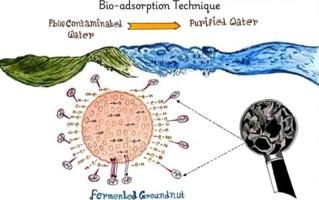Green functionalization of Arachis hypogaea shells via Aspergillus-mediated SSF for efficient Pb(II) removal: Kinetics, mechanism and economic evaluation
Q1 Environmental Science
引用次数: 0
Abstract
A novel eco-friendly adsorbent was developed by modifying Arachis hypogaea (groundnut) shells using Aspergillus niger mediated solid-state fermentation (SSF). The SSF technique is a unique, cost-effective, and environmentally friendly method to improve the structural properties of the adsorbent. This green functionalization enhanced the adsorptive performance without chemical treatment. Characterization through FTIR and SEM revealed the introduction of active functional groups and increased porosity. The maximum Pb(II) removal capacity of fermented groundnut shell (FGS) reached 36.82 mg/g at pH 5.0, outperforming the raw shell (3.53 mg/g). Adsorption followed the Langmuir isotherm and pseudo-second-order kinetics, with film diffusion as the primary mechanism. Thermodynamic analysis indicated spontaneous and endothermic adsorption, while regeneration studies showed over 30% efficiency retention after two cycles. The process reduced treatment cost by over tenfold. Furthermore, the treatment of raw industrial effluent also shows significant decreases during the batch adsorption process. This study offers a sustainable alternative for heavy metal remediation using agro-waste and fungal biotechnology.

通过曲霉介导的SSF对花生壳进行绿色功能化高效去除Pb(II):动力学、机制和经济评价
利用黑曲霉介导的固态发酵(SSF)对花生壳进行改性,制备了一种新型环保型吸附剂。SSF技术是一种独特、经济、环保的方法,可以改善吸附剂的结构性能。绿色功能化提高了吸附性能,无需化学处理。通过FTIR和SEM的表征发现了活性官能团的引入和孔隙度的增加。发酵花生壳(FGS)在pH 5.0条件下对Pb(II)的最大去除率达到36.82 mg/g,优于生壳(3.53 mg/g)。吸附过程遵循Langmuir等温线和拟二级动力学,以膜扩散为主要吸附机理。热力学分析表明,这是自发吸附和吸热吸附,而再生研究表明,经过两个循环后,效率保持在30%以上。该工艺将处理成本降低了十倍以上。此外,在间歇吸附过程中,对工业废水的处理也显着降低。该研究为利用农业废弃物和真菌生物技术修复重金属提供了一种可持续的替代方案。
本文章由计算机程序翻译,如有差异,请以英文原文为准。
求助全文
约1分钟内获得全文
求助全文
来源期刊

Bioresource Technology Reports
Environmental Science-Environmental Engineering
CiteScore
7.20
自引率
0.00%
发文量
390
审稿时长
28 days
 求助内容:
求助内容: 应助结果提醒方式:
应助结果提醒方式:


